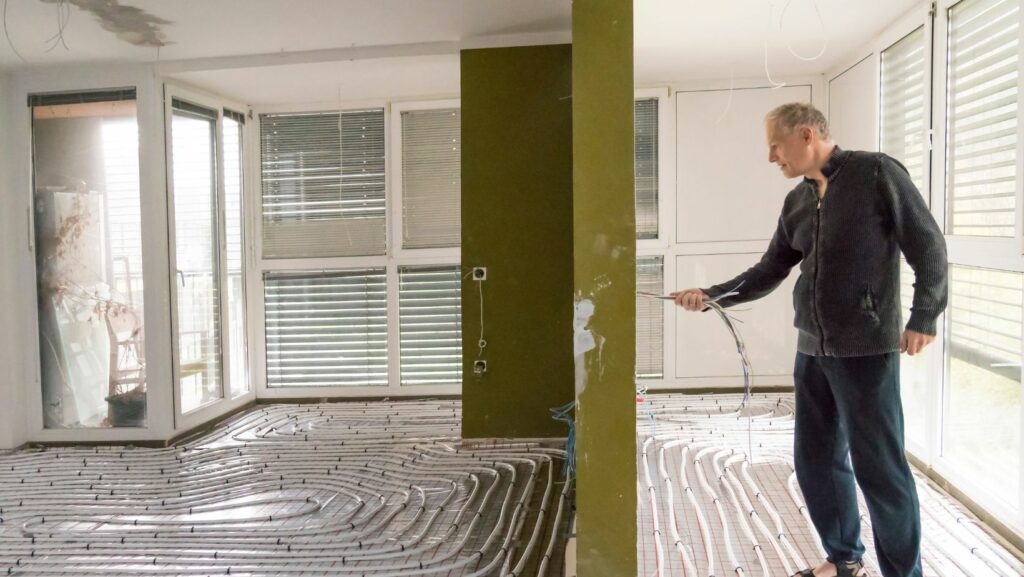When it comes to comfort at home, few features rival the cozy warmth of heated floors. Floor heating systems offer a luxurious and efficient way to maintain an even indoor temperature, eliminating cold spots and enhancing comfort throughout the house. However, choosing the right heating system depends heavily on your subfloor type, flooring material, and personal needs. From basements to bathrooms, and concrete slabs to vinyl planks, different environments call for different solutions. This guide breaks down the top flooring scenarios and explores which radiant heating system fits best, so you can make an informed decision for optimal warmth and performance.
1. Heating Under Concrete Subfloors
Concrete is commonly found in basements and ground-level rooms, and while it’s durable, it tends to feel cold underfoot. Hydronic (water-based) radiant heating is the ideal solution for these areas. Tubing is embedded directly into or over the concrete slab, delivering consistent heat across the surface. This setup is energy-efficient, especially when used with thermal mass like tile or stone that retains heat well. Before installation, it’s essential to include proper insulation beneath the slab to prevent heat loss downward and ensure maximum comfort and efficiency.
2. Heating Over Plywood Subfloors
Plywood is the standard subfloor material in many multi-story homes. Electric radiant heating systems work well here, especially when installed between joists or under a thin underlayment. These systems are relatively easy to retrofit and provide rapid, targeted heat. Plywood can also support hydronic systems with the addition of panels or tracks for tubing. When choosing flooring, opt for engineered wood or vinyl that’s rated for radiant heat. Always follow manufacturer guidelines to prevent damage and ensure even heating across the surface.
3. Heating with Vinyl Plank Flooring
Luxury vinyl plank flooring is an increasingly popular option for homeowners seeking the look of hardwood with water resistance and low maintenance.

When it comes to underfloor heating, radiant heat under vinyl plank flooring is not only possible but highly effective if you choose the right product. Modern vinyl planks are designed to be compatible with radiant heating systems, especially electric mats and hydronic tubing embedded in underlayment panels. These planks transfer heat efficiently while resisting warping. It’s important to select flooring with a low R-value for better heat conduction and check the maximum temperature limits to avoid damaging the planks.
4. Heating in Moisture-Prone Areas
Bathrooms, laundry rooms, and kitchens benefit greatly from floor heating, as these are the spaces where stepping onto a cold floor can be most uncomfortable. Electric radiant mats are typically favored here due to ease of installation and the small area coverage required. Tile is the preferred flooring material in wet areas, thanks to its excellent thermal conductivity and water resistance. However, some waterproof vinyl and engineered options also perform well if installed with proper sealing and underlayment. Always prioritize materials that resist moisture without compromising on heat transfer.
5. Heating in High-Traffic Zones
Hallways, entryways, and living areas experience constant foot traffic, so your floor heating solution must balance durability and thermal efficiency. Both electric and hydronic systems are suitable, depending on whether you’re building new or renovating.

Porcelain tile and engineered hardwood perform well in these spaces. For quicker heating response times, electric systems may be preferred, especially when paired with thin, conductive flooring. If you’re planning to use laminate or vinyl in these areas, ensure they’re approved for radiant systems and can withstand repeated heating cycles without deteriorating.
Conclusion
Selecting the right floor heating system involves more than choosing between electric and hydronic, it’s about matching the system with your subfloor and floor covering for safe, efficient, and lasting comfort. Whether you’re considering radiant heat under vinyl plank flooring or installing heating under a tiled bathroom, understanding the needs of each space will help you achieve the cozy home environment you envision. Make warmth a permanent feature of your floor by planning smartly from the start.

